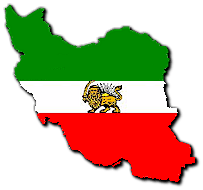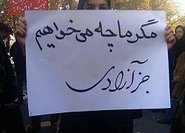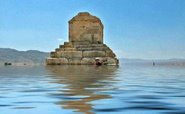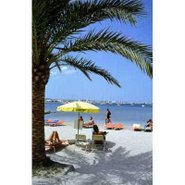May 01, 2008 - The New York Post - Amir Taheri
'A Man of God and an enemy of the Great Satan": That's how Iran's official media described Fernando Lugo - the Paraguayan ex-priest who just won his country's presidency in a hotly contested election.Iran's President Mahmoud Ahmadinejad - among the first foreign leaders to congratulate Lugo on his win - hopes that Paraguay will now become another link in what he calls "the counter lasso" - the chain of anti-US regimes he's supporting with the help of his "brother," Venezuelan President Hugo Chavez.Ahmadinejad's analysis is simple: America is trying to throw a lasso around Iran with the help of allies in surrounding regions. So Iran should throw a counter lasso via an alliance in the United States' South American backyard.
The Vatican had rejected Lugo's resignation from the priesthood but suspended him after he ran for office despite being denied permission. He visited Iran in the '90s to pay homage to the late Ayatollah Ruhollah Khomeini - whom Lugo has praised as "a forerunner of the modern global revolutionary movement."Since the late '80s, the Iranian-run Hezbollah, a global movement of Khomeinist militants, has built a base in Paraguay by recruiting in the Shiite community, about 15 percent of the population. That base played a key role in ensuring Lugo's victory, especially via a big fund-raising campaign backed by Iran and Venezuela.Cuba was the first Latin regime to forge an informal alliance with Iran. In the last 18 years, Iran has injected billions into Cuba's ailing economy, partly by providing free crude oil.But only in the late '90s did Tehran find a true Latin ally in Chavez - who has visited the Islamic Republic six times, setting a record for any foreign leader. He's helped Iran create a radical axis in OPEC, with Libya and Algeria as occasional allies.Tehran-Caracas ties deepened after Ahmadinejad took office, as the Islamic Republic revived its militant anti-US policy. Iran's president has visited Latin America four times in three years, more than any other region. That influence has played a crucial role in encouraging Chavez's increasing anti-American posture.Ahmadinejad and Chavez have reason to be pleased with their work: America is clearly in retreat in its own backyard.At the start of the new century, Brazil already had a moderate leftist regime under President Luiz Inacio Lula da Silva. Since then, Bolivia also elected a leftist firebrand, President Evo Morales.Chile, Argentina and Uruguay have all opted for moderate-leftist governments. Even in Peru, the return of Alan Garcia as president has revived the left's corpse.Ecuador's new president, Rafael Correa, has suspended talks for a free-trade pact with the United States and threatened not to renew the lease for the US air base at Manta. Ecuador has also returned to OPEC, increasing Iranian/Venezuelan influence there.In Nicaragua, the Sandinistas have regained power under President Daniel Ortega - who highlighted his alliance with Ahmadinejad by making Iran the first non-Latin country he visited after taking office.Lugo's win in Paraguay completes the leftist takeover in the region. South of Mexico, the only puzzle piece still tilting rightward is Colombia under President Alvaro Uribe.And a campaign is under way to "get Uribe." American leftists are trying to help by derailing the US-Colombia free-trade accord. Venezuela, meanwhile, has made military demonstrations on the Colombian border while increasing support for Colombia's narco-Marxist terrorists.All this confirms Ahmadinejad's belief that the global tide is turning against the United States. "The US is on a slippery slope to destruction," he told crowds in Tehran earlier this month. The phrase has become an official slogan, inscribed on podiums used by the president and others high in the revolutionary establishment.Tehran has signed contracts worth $40 billion with Caracas - a huge sum considering the modest size of Venezuela's economy. And it has negotiated $30 billion more in contracts with Bolivia, Nicaragua and Ecuador. (Iran's business relations with Cuba, Brazil and Peru are also booming.) These contracts come in four areas:Energy: Iran's aim is to replace as many US companies as possible in the Latin American oil and gas industry. A joint Irano-Venezuelan consortium hopes to dominate the natural-gas sector in Bolivia while launching new exploration schemes for oil and gas in Nicaragua, Ecuador and Peru.Arms: No Latin country has a credible weapons industry; Iran hopes to fill the gap. It has sold $4.5 billion worth of armaments to Venezuela and is training hundreds of Venezuelan military personnel.Security: Iranian and Venezuelan security services have set up a coordination committee and developed a system of exchanging information. Nicaragua is expected to join soon, as are Cuba, Bolivia and Ecuador.Media: The first step here has come in a $1 billion Iranian investment in developing a Spanish-language TV network to compete with the major US satellite channels.The Monroe Doctrine, designed to deny European powers a dominant role in the Americas, apparently doesn't apply to Iran - which is determined to carve its own Latin American zone of influence.As Ahmadinejad likes to tell his Latin American hosts: The Americans are going, the Iranians are coming.
Bluff and Bloodshed - By Newsweek Web Exclusive
The Persian Gulf is more dangerous than ever. Will the U.S. and Iran go to war at sea?
Iraq Team to Discuss Militias With Iran
BAGHDAD -- The Iraqi prime minister is sending several senior Shiite leaders to Tehran to discuss their concerns that Iran is arming and financing militias in Iraq, senior Iraqi and American officials said Wednesday. more
Rules of Disengagement
What's valued at more than 231 billion dollars? Answer: the assets of some 3.8 million current and former federal employees, everyone from letter carriers to U.S. Senators, whose retirement funds are socked away in the Thrift Savings Plan (TSP), one of the largest and fastest-growing 401(k)-style funds in the U.S. more

























 اخبار مربوط به زندانیان سیاسی و نقض حقوق بشر
اخبار مربوط به زندانیان سیاسی و نقض حقوق بشر

















 Tulips in Holland
Tulips in Holland












No comments:
Post a Comment